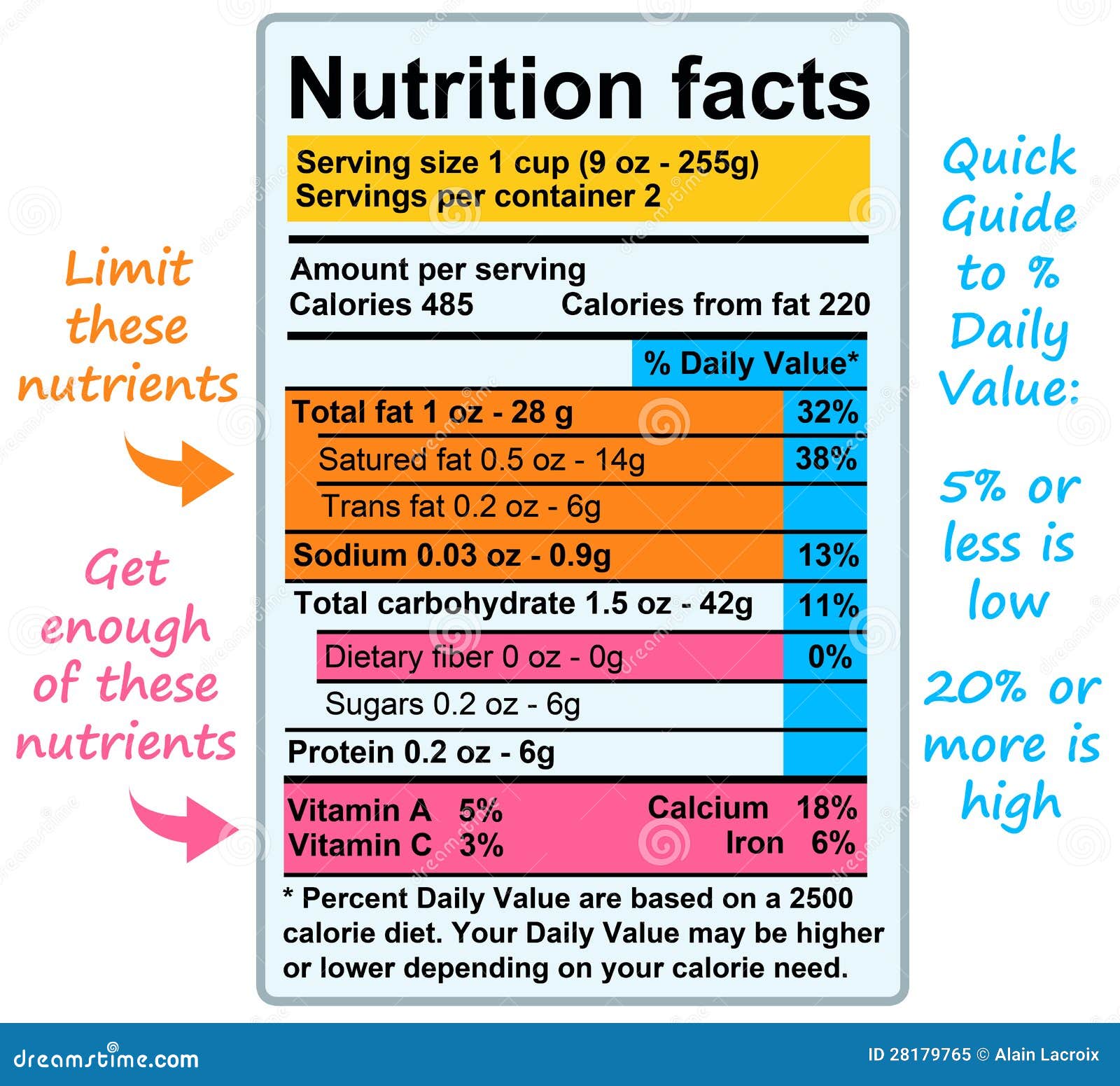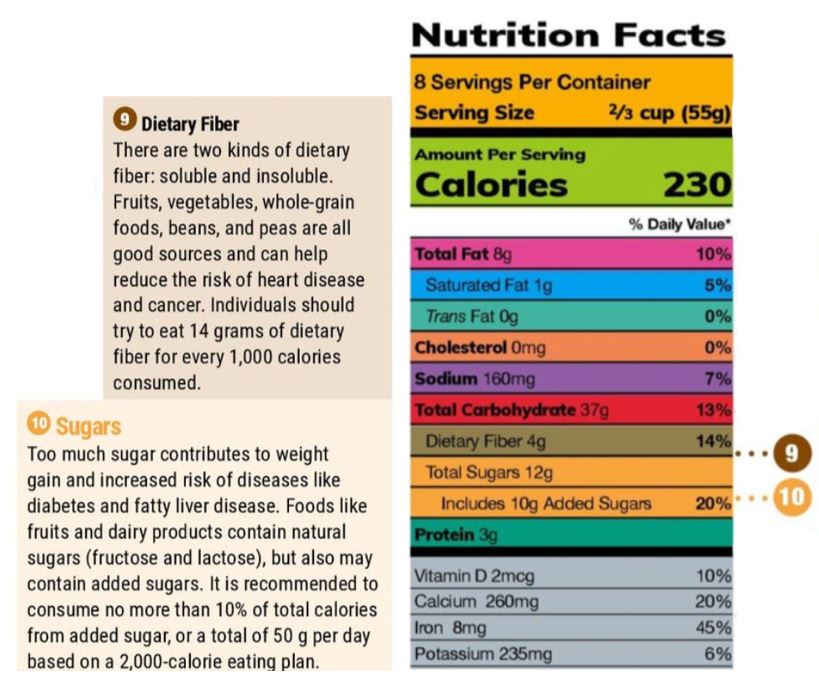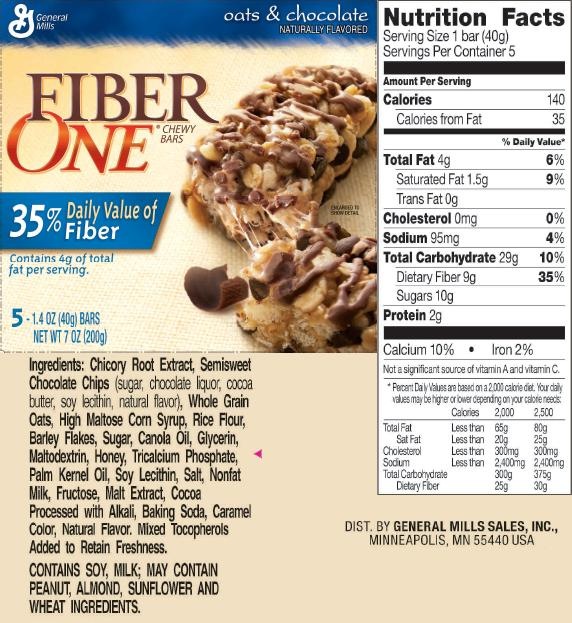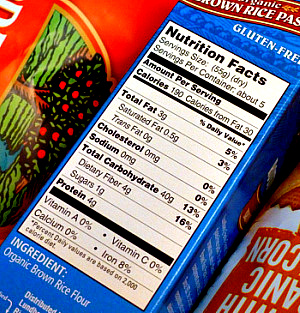45 dietary fiber on food labels
PDF A Guide to Reading Food Labels - University of Rochester Dietary Fiber 0g ... Check the serving size on food labels to determine if the number of servings you are eating is smaller or larger. This will help you stay within your daily calorie goal. Calories . The number of calories is the total amount of energy the food provides. Pay attention to calories. Food Labels | Nutrition.gov What's New with the Nutrition Facts Label. HHS, Food and Drug Administration. The U.S. Food and Drug Administration (FDA) has updated the Nutrition Facts label on packaged foods and beverages with a fresh design that will make it easier for you to make informed food choices that contribute to lifelong healthy eating habits. What's in a Name?
Food labels - Purdue Extension Nutrition Label Format The nutrition label on a package uses Daily Value as a reference. Daily Values (DV's) provide a basis to compare certain food components - total fat, saturated fat, cholesterol, sodium, total carbohydrate, dietary fiber, sugars, and protein. These nutrients are listed on all nutrition labels.

Dietary fiber on food labels
Fiber & Food Labels | Home & Garden Information Center Nutrition Facts labels list goals for Americans as 25 grams of dietary fiber per day for a 2,000-calorie diet and 30 grams per day for a 2,500-calorie diet. Food is considered a high source of fiber if the % Daily Value listed on the Nutrition Facts label is 20% or more. It is a low source of fiber if the % Daily Value is 5% or less. Learning To Read Labels - Diabetes Education Online On a nutrition food label, subtract the fiber from the total carbohydrate amount. When you read food labels, the grams of sugar are already included in the total carbohydrate amount, so you do not need to count this sugar amount separately. The grams of sugar listed include both natural sugars, from fruit or milk, and added sugars. FDA Rounding Rules for Your Food Label - LabelCalc Total Carbohydrate, Dietary Fiber, Sugar, and Protein. If your product has: ... It might come as no surprise that in 2022, there are more than one way to create nutrition facts labels for your food products. Because we live in a digital age, where data is easily accessible, food manufacturers aren't restricted to outsourcing nutrition facts ...
Dietary fiber on food labels. Interactive Nutrition Facts Label Download the Dietary Fiber Fact Sheet. (PDF: 320 KB) Nutrition Facts 4 servings per container Serving size 1 1/2 cup (208g) Amount Per Serving 240 Calories % Daily Value* 5% Total Fat 4g 8%... › health › food-nutritionHow Much Fiber Per Day? Grams, Sources, Benefits, and More Apr 11, 2022 · According to the Food and Drug Administration, the Daily Value for fiber is 28 grams per day for adults on a 2,000-calorie diet. This number may also depend on age or sex. Children ages 1 to 18 ... › in-depth › fiberDietary fiber: Essential for a healthy diet - Mayo Clinic Jan 06, 2021 · Dietary fiber — found mainly in fruits, vegetables, whole grains and legumes — is probably best known for its ability to prevent or relieve constipation. But foods containing fiber can provide other health benefits as well, such as helping to maintain a healthy weight and lowering your risk of diabetes, heart disease and some types of cancer. Your Guide to Nutrition Labels | EatingWell 8. Dietary Fiber. As high as possible (aim for 25 grams for women or 38 grams for men daily). 9. Sugars. Interesting but not always useful, since labels don't discriminate between naturally occurring sugars (such as in milk or fruit) and added sugars. 10. Vitamins and minerals.
Dietary Fiber on the Food Label - Fiber Facts Each ingredient in a food or beverage is listed on the package label alongside the Nutrition Facts Label. Fibers may be listed as a type of flour (e.g., wheat, rye, and oat) or as individual fibers. It is important to eat a wide range of dietary fibers from different sources to get all the benefits that fiber can provide. Fiber | Nutrition.gov This page provides lists of which foods have the most and least content of specific nutrients. Make Half Your Grains Whole Grains USDA, Food and Nutrition Service, Center for Nutrition Policy and Promotion Whole grains are important sources of many nutrients, including dietary fiber. Discover new ways to enjoy whole grains with these tips. How are Carbohydrates & Dietary Fiber Labelled on Foods? The fibers listed below are the most common sources being added to food and can be declared on the Nutrition Facts label as dietary fiber. FDA approved isolated and synthetic non-digestible carbohydrates Gum Acacia Alginate Apple Fiber Bamboo Fiber Carboxymethylcellulose Corn Hull Fiber Cottonseed Fiber Galactooligosaccharides How To Read Food and Beverage Labels | National Institute on Aging Although frozen and canned fruits and vegetables have food labels, fresh varieties often do not. You can find nutrition information for fresh vegetables and fruits on the USDA website. Or you can call the U.S. Department of Agriculture's Food and Nutrition Information Center at 301-504-5414. Understanding percent Daily Value (% DV)
Reading Food Labels | ADA - American Diabetes Association The Nutrition Facts labels on foods are really the key to making the best choices. We'll cover the basics so that these labels make shopping easier for you. Get started Understanding Carbs You've heard it all. From carb-free to low-carb, to whole and empty carbs, it's hard to know what it all means. Learn more Food & Blood Sugar Fiber on Nutrition Facts Labels - Calorie Control Council In fact, the Institute of Medicine recommends that women ages 19-50 consume 25 grams of fiber per day and males should consume 38 grams of fiber per day. After the age of 50, that number is reduced to 21 grams/day for women and 30 grams/day for men. If you're searching for the amount of fiber on a nutrition facts label, first locate ... PDF Eat Smart with Food Nutrition Labels Compare labels when possible and . choose options with lower amounts of added sugars, sodium and saturated fat and no trans fat. Get enough of . beneficial nutrients. Eat foods with nutrients your body needs, like calcium, dietary fiber, iron, potassium . and Vitamin D. Understand % Daily Value. • The % Daily Value (DV) tells you the PDF Interactive Nutrition Facts Label - Dietary Fiber Interactive Nutrition Facts Label • March 2020 wwwaovnutritioneucation Dietary Fiber 1 Dietary Fiber. Diets higher in dietary fiber can increase the frequency of . bowel movements and can reduce the risk of developing cardiovascular disease. What It Is . Dietary fiber is a type of . carbohydrate. made up of many sugar molecules linked together.
Understanding Food Labels - Nutrition: Science and Everyday Application The value printed on the Nutrition Facts panel is the percent DV, which tells you how much one serving of the food contributes towards meeting the daily requirement for that nutrient. The FDA uses the following definitions for interpreting the %DV on food labels:4. 5%DV or less means the food is low in a nutrient.
How to Understand and Use the Nutrition Facts Label | FDA Dietary fiber, vitamin D, calcium, iron ad potassium are nutrients on the label that Americans generally do not get the recommended amount of. They are identified as nutrients to get more of....
› en › healthy-livingWhole Grains, Refined Grains, and Dietary Fiber | American ... Nov 01, 2021 · Most refined grains contain little or no fiber. Dietary fiber can help improve blood cholesterol levels and lower your risk of heart disease, stroke, obesity and even type 2 diabetes. Fiber for the win! And here’s an awesome bonus if you’re trying to lose weight: fiber can help you feel full, so you’ll be satisfied with fewer calories.
Dietary Fiber on the Nutrition Facts Label | ESHA Research The final rule for FDA's 2016 updates to Nutrition Facts labeling incorporates two major changes to dietary fiber that food manufacturers need to be aware of: (1) a definition of "dietary fiber" - a term that FDA had not previously defined and (2) an increase in the DRV from 25 grams to 28 grams.
Dietary Fiber Labeling Cheat Sheet | ESHA Research Dietary Fiber is a mandatory label nutrient and is a non-digestible carbohydrate, and for US labeling, it is considered part of the carbohydrate total. Dietary Fiber includes both soluble and insoluble fiber, which can also be reported on the label.
Dietary Fiber Understand the New Definition - LabelCalc Dietary Fiber on the Food Label In the U.S., information about the amount of dietary fiber per serving appears in the Nutrition Facts Panel (on the side or back of packaging) unless the product contains less than one gram of fiber and no fiber claims are made. In the U.S. products that contain at least 10% of the daily value or … Continue reading
healthyeating.sfgate.com › subtract-dietary-fiberWhy Do You Subtract the Dietary Fiber From the Carb Count? Dec 12, 2018 · Since your body doesn't digest and metabolize fiber like other carbohydrates, you can subtract the grams of fiber lumped into the overall carbohydrate count on food labels. That means a higher-carbohydrate food that's chock-full of fiber might not be a bad choice. In fact, fiber helps slow down the absorption of the simple sugars you're trying ...
Dietary Fiber on the Food Label - Calorie Control Council In the U.S. products that contain at least 10% of the daily value or 2.5 grams of fiber per serving can claim they are a "good source of fiber" and those containing at least 20% of the daily value of fiber or 5 grams or more of fiber per serving can label the product with a high fiber claim.
Understanding Food Nutrition Labels - Heart When choosing among different brands or similar products, compare labels and choose foods with less of these nutrients when possible.. 4 - Get enough of the beneficial nutrients. Make sure you get enough of the nutrients your body needs, such as: calcium, choline, dietary fiber, iron, magnesium, potassium, and vitamins A, C, D and E.*
Understanding Food Labels | The Nutrition Source | Harvard T.H. Chan ... Under the Food Allergen Labeling and Consumer Protection Act of 2004, eight major food allergens—milk, fish, tree nuts, peanuts, shellfish, wheat, eggs, and soybeans—are required to be listed in a "contains" statement near the Ingredients list if present in a food. An example would be "contains wheat, milk, and soy."
Food Sources of Dietary Fiber | Dietary Guidelines for Americans Food Sources of Dietary Fiber. Dietary Fiber: Nutrient-densea Food and Beverage Sources, Amounts of Dietary Fiber and Energy per Standard Portion. a All foods listed are assumed to be in nutrient-dense forms; lean or low-fat and prepared with minimal added sugars, saturated fat, or sodium. b Some fortified foods and beverages are included.
What does dietary fiber mean on a food label? - AskingLot.com Dietary Fiber on the Nutrition Facts Label. Dietary Fiber is a mandatory label nutrient, and for U.S. labeling, it is considered part of the carbohydrate total. Dietary Fiber includes both soluble and insoluble fiber, which can also be reported on the label. Click to see full answer. Consequently, what does dietary fiber mean?
Food Labels | CDC If you eat the whole thing, you are eating 8 times the amount of calories, carbs, fat, etc., shown on the label. Total Carbohydrate shows you types of carbs in the food, including sugar and fiber. Choose foods with more fiber, vitamins, and minerals. Choose foods with lower calories, saturated fat, sodium, and added sugars. Avoid trans fat.
Questions and Answers on Dietary Fiber | FDA Dietary fiber that can be declared on the Nutrition and Supplement Facts labels includes certain naturally occurring fibers that are "intrinsic and intact" in plants, and added isolated or...
This Is How to Read a Nutrition Facts Label on the Keto Diet Depending on the daily carb intake you've determined for yourself to stay in ketosis, this is a quick way to determine whether you have room in your daily eating plan for a particular food. (Remember, a ketogenic diet is typically a ratio of about 70-75% fat, 15-25%+ protein, and 5% or less of calories from carbs.)
FDA Rounding Rules for Your Food Label - LabelCalc Total Carbohydrate, Dietary Fiber, Sugar, and Protein. If your product has: ... It might come as no surprise that in 2022, there are more than one way to create nutrition facts labels for your food products. Because we live in a digital age, where data is easily accessible, food manufacturers aren't restricted to outsourcing nutrition facts ...
Learning To Read Labels - Diabetes Education Online On a nutrition food label, subtract the fiber from the total carbohydrate amount. When you read food labels, the grams of sugar are already included in the total carbohydrate amount, so you do not need to count this sugar amount separately. The grams of sugar listed include both natural sugars, from fruit or milk, and added sugars.










Post a Comment for "45 dietary fiber on food labels"